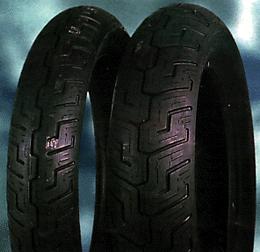![]()
|
Hydroplaning IssuesHydroplaning is the result of your tires moving FAST across a wet surface - so fast that they do not have sufficient time to channel that moisture away from the center of the tire. The result is that the tire is lifted by the water away from the road and all traction is thus lost. Of course the word 'fast' is a relative term. Tread design, tread depth, weight of motorcycle, tire pressure, depth of water and even the consistency of that water - (whether it is highly aerated or not, for example) - all play a part in determining at what speed the tire will begin to hydroplane. It is a pretty safe bet to assume that any speed in excess of 60 MPH is fast enough to support hydroplaning regardless of the other variables. This is not to say that at 55 MPH you are safe, however. (A formula that comes close to predicting the speed at which you will hydroplane, assuming at least .2" of water on the ground, is: 10.27 * Sqrt(tire pressure) which shows that if your tires hold 35 PSI, hydroplaning can be expected at 60.76 MPH, while tires with 41 PSI of air in them should expect hydroplaning at about 65.75 MPH. Another formula that is somewhat more accurate, though much harder to calculate, is: 7.95 * Sqrt(tire pressure * contact patch width / contact patch length). This formula shows that the wider the contact patch is relative to its length, the higher the speed required to support hydroplaning.) In any event, there are two absolutely essential NO-NO's to remember should you experience the beginning of hydroplaning: Hope there is an idea in there that you can work with. Frankly, I think if you start to hydroplane the odds are that you are going to go down unless you keep the front wheel pointed absolutely dead ahead and it is of the briefest of durations. While on this subject I would like to make another observation about our tires. If you look at the stock front tire on all new Goldwings you will see a Dunlop K177.
However,
if you look at the front tire tread pattern of the new
Dunlop Elite II's (K491) they are aligned in exactly the opposite way.
That is, they tend to channel water towards the center of the tire.
This CANNOT be the most effective way to diminish the odds of
hydroplaning! Either the K177 or the K491 is safe If anyone knows why I sure would like to hear about it. Thanks. I, of course, tried to find out the answer for myself. I wrote to the company that manufactures these tires and in my letter I explained my concerns, just as I did above. Following is the terse response I received from the Dunlop Tire Corporation to those concerns. I think you can draw a few conclusions from this 'hedge" - at least one of which is that hydroplaning and braking compete with each other from a tread design point of view. It might also be concluded that if you start using these newer designs you should lower your speeds in the future when the roads are wet, below what used to work just fine for you (I will!). Our development and testing during the design of the Elite II front tire determined optimum overall performance was achieved with this pattern which includes wet traction and braking.
(This response was signed by a person named Tom Daley.) Mind you that I am not of the opinion that Dunlop has made a mistake with this design! In fact, I think braking performance is FAR MORE IMPORTANT than hydroplaning resistance. This is particularly true since we can usually choose how fast we drive on wet streets but often cannot choose when it is necessary to stop quickly. I would have liked a little more candor from them on the issue, however. For example, (because it is left to me to interpret their response), I do not know if they were actually saying that they had determined that the old design (such as IS being shipped on the front tires of new Wings) is better or not than the K491 design from an hydroplaning point of view. My opinion on the matter is that if you have a choice you should get excellent hydroplaning design on the rear tire (where I believe you need it more) and best possible braking traction design on the front tire. Return |

 If
you look at the tire tread pattern you will also see that the grooves
are cut in such a way as to tend to channel water away from the center
of the tire if it is rotating in accord with the arrow stamped on the
side of the tire. This seems to be consistent with what the Dunlop
factory rep advised in his latest message to me on the subject.
If
you look at the tire tread pattern you will also see that the grooves
are cut in such a way as to tend to channel water away from the center
of the tire if it is rotating in accord with the arrow stamped on the
side of the tire. This seems to be consistent with what the Dunlop
factory rep advised in his latest message to me on the subject. r
on wet streets based on those tread patterns. (I believe that most new
street bikes (other than Honda) come with tires treaded like the
K491's.)
r
on wet streets based on those tread patterns. (I believe that most new
street bikes (other than Honda) come with tires treaded like the
K491's.)